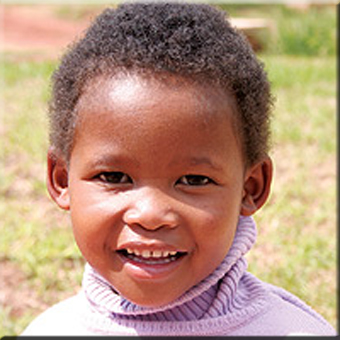Ravaged by HIV/AIDS, women and children from a South African squatter camp find hope at a volunteer-run clinic.
Two years ago Selinah was lying on a mat at the altar of the Catholic mission in Phokeng, South Africa. Weighing only 86 pounds, she shivered with fever as the AIDS virus took over her body. Surrounded by other patients of the Tapologo AIDS Hospice, run by the Catholic Diocese of Rustenburg, she prayed for her life as the community anointed her.
"My only hope was to pray each and every day that God would give the [antiretroviral] tablets the strength to heal me," she says. Every day she sang a song of hope. Translated into English, the song says, "You must be strong. You must be brave… We will find the way."
Now she's back to a healthy weight of 120 pounds and is filled with the urgency that only a brush with death can give. She was elected as a community representative in Freedom Park, the squatter camp that sits near the edge of the platinum mines where people come from all over South Africa and its neighboring countries to find work. When people in her neighborhood have a problem with the housing commission or any other governmental agency, Selinah navigates the red tape on their behalf.
Now 39 years old, Selinah has given birth to three sets of twins-six boys-but also had to bury three of these children. Four years ago, she had a girl and named her Karabo, which means "answer," because she finally got a girl child. Unfortunately Karabo also became sick, so Selinah brought her to Sister Georgina Boswell, one of the founders of Tapologo and a registered nurse. Karabo was diagnosed with HIV, and then it was time for Selinah to reveal the secret she had kept for seven years: She was also HIV-positive.
Now she sticks to her strict regimen of antiretroviral medications, with which she has had amazing success. She goes to the Tapologo clinic in Freedom Park every Wednesday to pick up the medicine for her and her daughter and spends time visiting with the other patients. Together they pray and sing. At the clinic it is mostly women and children, but the range in age is broad. These are the ones who have HIV but are healthy enough to live at home.
When they become too ill, they are transferred to the inpatient hospice, a 20-bed facility on the campus of the Rustenburg diocesan mission that was built to give people a place to die with dignity. It actually has a survival rate of almost 50 percent. Bishop Kevin Dowling of Rustenburg attributes the high rate of discharge to the stark contrast between the conditions of the hospice and the conditions of the patients' everyday lives. The people in the community live in abject poverty, many sleeping in shacks made of pieces of corrugated tin or zinc. They have no running water or sanitation, and most do not have enough to eat. So when they are placed in a clean, comfortable, and loving environment with proper medical care and enough food, the potential for improvement is enormous.
The state hospitals are notorious for poor care and long waiting lines. And astoundingly most do not even have antiretroviral treatment available, despite the fact that South Africa is home to 6.5 million people who are HIV-positive. Many theories, from lack of funds to criminal neglect, circulate as to why the government has failed to address the pandemic.
After the government, the Catholic Church has the largest network of programs addressing HIV/AIDS in South Africa. Dowling sees places like Tapologo as the most natural Catholic reaction to the suffering of its people. "Our most important mission as a church is to heal the wounded in our midst and work for justice. The Catholic Church should be a compassionate, caring, people-centered church," he says.
Dowling tells the story of a little boy named Nelson, who came to the hospice from the public Rustenburg Hospital, where he was dying of AIDS and related infections. "He had meningitis, and it had gone to his brain. He became blind and was partially deaf," Dowling says. "And they sent him home because they don't care for people who are dying. Our homecare nurses picked him up and brought him to the hospice. I arrived there to find him curled up in the fetal position on the bed, looking at the wall, not saying a word. But our nurses loved him to bits, and three days later he was sitting up in a chair.
"Then we had a visit from Miss South Africa, Claudia Henkel, and she talked to him. He told her, ‘It's so nice here. Every morning the sisters wash me, so I'm clean. There are clean sheets every day. They give me such good food, and they love me, and they care for me.' He died there, but the nurses loved him into a peaceful death, a death with dignity."
The caregivers and nurses of Tapologo are the backbone of the operation. Those who are trained as registered nurses and nurse's assistants run the nine neighborhood clinics and examine the patients. Caregivers talk to the patients, process their information, cook the small meal that is provided to the patients, make weekly home visits to those who need it, lead support groups, and raise awareness in the community, among many other tasks. Many of them are HIV-positive themselves. And although the stipend for a caregiver is not much, between $40 and $100 a month, it helps a little, and the women find pride in their work.
The caregivers are all local people, mostly women, but a few men. One of the great benefits of the job is that those who show promise are trained as assistant nurses, a rare opportunity for upward mobility and advanced education. The caregivers speak of the difference their job has made in their lives, giving them confidence, pride, and a sense of purpose, which is particularly important in a county with recognized problems of abuse of women and male domination in cultural, social, and professional realms.
Often they go above and beyond the call of duty by taking patients into their homes who have nowhere to stay. Recently Thembi, a caregiver whose name means "hope," took in a patient who was homeless, a young woman with a little boy. The woman was in need of surgery on her back. Ten years ago she was raped by her father, which caused severe damage to her spine.
Another group working to empower women infected and affected by the HIV/AIDS pandemic comes from a perhaps unlikely place: a local platinum mine, one of the largest companies in South Africa. Although the vast majority of employees at its mines are men, Implats Platinum has recognized the impact of HIV/AIDS on its company and is seeking out creative ways to address the many causes and effects of the disease. Mining attracts many workers from outside the local area, and traditionally these workers come to live at the mine on their own without their wives and families. In the past miners were actually required to live in company hostels, which produced a range of cultural problems, including a high prevalence of extramarital relationships, alcohol and drug abuse, and the use of sex workers, all of which have contributed to a 16 percent HIV infection rate among Implats workers.
Implats now has an entire division of its company dedicated to HIV/AIDS prevention and treatment. An innovative program features a group of 42 sex workers who raise awareness about HIV and encourage the use of condoms. They make presentations at pubs, putting on skits and singing songs about the dangers of HIV and unsafe sex. In the past three years, not one of these 42 women has been diagnosed with HIV or any other sexually transmitted disease or become pregnant. The women receive a stipend for their work on the project.
The issue of women being forced to sell their bodies for money is difficult to remedy in an impoverished environment with jobs, opportunity, and education in short supply. Dowling says he does not regard these women as sex workers or prostitutes, because they have no choice. "They are not engaging in this in any sense freely. They have no option, and I know there is no other option. There is no sense of relationship with the men. They are abused, they are absolutely imprisoned in this hellish life, and they're dying because they're infected, and repeatedly infected by having numerous sexual encounters with men who are HIV-positive."
Margaret is 27 years old and found out she had AIDS in January 2006, when her disease was already full-blown. Dark spots had been developing on her face over the course of a few years. She now knows them to be Kaposi sarcoma, the skin lesions commonly associated with AIDS patients. It is actually a type of cancer, a malignancy of the blood vessels and connective tissue caused by human herpesvirus 8. This sarcoma occurs not only on the skin but on internal organs. Margaret suffered from severe stomach pain, but doctors kept telling her it was just an ulcer. And they had no answers for her facial lesions.
When her condition worsened to a critical state, her aunt brought her to the clinic in Phokeng, where she was finally tested for HIV. She entered the inpatient hospice unit at the end of March, and her condition is improving, but she still has bad days when her appetite is gone, she's nauseous, and has coughing fits.
Walking into the hospice, Margaret greets you with a warm hug and smile, introducing you to all the friends she has made in the other patients. She talks about things she'll do when she is discharged and is not at all resigned to her illness, though physically it is taking a visible toll. But with her determination, she gives life to those around her as well.
At Tapologo the message is to be open about the disease, to bring it out of the shadows. That's why the caregivers go out into the community, instead of simply waiting for people to come to them. They say that sometimes people are shocked at first to hear someone speaking openly about HIV, and they don't want to hear about it. But in a community with HIV prevalence rates as high as 38 percent in the adult population, not a soul is untouched by the disease. Everyone knows someone who has died. Some have lost their whole families.
Today was a long day at the clinic, with patients coming in from 7 a.m. until 5 p.m. Antiretroviral regimens have been dispensed, more than 100 patients have been seen by just one nurse, the volunteer doctor has seen those who need critical care, the caregivers have made their rounds to patients' homes and some will inevitably make more visits in their free time this evening.
As the staff leaves the clinic, they hop into the Tapologo ambulance, but the aging van needs a push to start, so some stay out and shove. The woman in the passenger seat gives a thumbs-up, and the others jump into the moving van through the open sliding door. As they drive away, the words painted on the side of the van, "Tapologo Has Life," fade into the dusty road.
This article appeared in the January 2007 issue of U.S. Catholic (Vol. 72, No. 1, pages 24-28).














Add comment